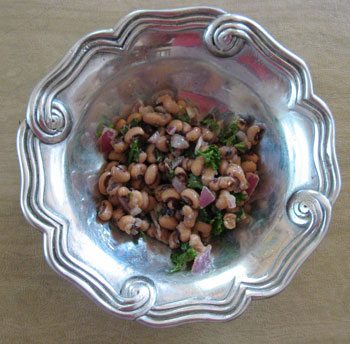Our Simanim Experience

I wanted to have all the simanim (food symbols) on the table for the first night of Rosh Hashana. I got really close. I just forgot the dates. Oooops. Only my husband missed them, as he’s the only one who likes dates.
In the past, I would say to my husband a few days before Rosh Hashana, now, what are the special foods we need to get? And he would mention maybe carrots and beets, and we would say a yehi ratzon on the carrots in the soup. When I was growing up, I don’t remember doing the yehi ratzon prayers at all. In fact, my father, who joined us for most of our Rosh Hashana meals, thought we should save the pomegranate for the new fruit, which one does on the second night of Rosh Hashana. My husband pointed out that we had eaten pomegranates within the last year, and one is really supposed to say the shehiyanu, the prayer for something new, on a fruit that one has not eaten in the past year.
So this year, because I did all this research on the simanim (thank you, readers, for your encouragement along the way as I posted various foods), I was the expert.
Back to the first night…so we have all these simanim on the table. With the help of Mimi’s Israeli Kitchen, I made the black-eyed beans (peas?) into a bean salad. She used: “seasoning it with a little chopped onion and a handful of mixed, chopped, cilantro, parsley, and celery tops. Lots of fresh lemon juice, to balance the earthy taste of the peas (which are really beans, but never mind) – salt and white pepper.”
Here’s my bean salad ingredients:
- Black-eyed beans, soaked overnight and cooked in a crockpot
- Chopped red onion
- Chopped fresh parsley
- Fresh lemon juice
- Some olive oil
- Salt and pepper
I was considering making a beet salad (Mimi made one: “some thinly sliced onion, salt, pepper, a little cumin, olive oil, a little sugar, and vinegar”), but as time didn’t allow (I was chaffeuring kids to play dates and art class in between cooking and doing a little of my web work), I just made steamed beets and cut them up.
What to do with leeks? Mimi posted a delicious leek tart (same post); I decided to incorporate the leeks with my chicken soup and with my roasted chicken with apples and mushrooms (I stuck one leek inside the chicken). I had more leeks than I needed, as I bought two sets; the first set of leeks didn’t look so good, and I had to go back to the supermarket on Monday morning anyway, so I bought a fresher set of leeks. The not-so-nice leeks are now resting in my compost pile which will hopefully be decomposed by next spring and will provide a new spot for growing tomatoes.
I made stuffed squash for the k’ra, the siman that can be a gourd, squash or pumpkin. I used Mimi’s stuffed artichoke post for inspiration on the stuffing. Hers had more ingredients; I had chopped meat, onion and spices in mine. I added chopped fresh ginger, too.
For the carrots, I went for simple. I liked the idea of cutting the carrots like coin-shapes.
Do you think I put a fish or lamb’s head on the table? I did the same thing I did last year, which was cut a piece of gefilte fish into the shape of a fish head and use a bit of cooked carrot for the eye.
Finally, I did one “joke” of a siman, which was to steam a “head” of broccoli.
The problem was, it was late, we were all tired, and my eldest son only liked the pomegranate. So after doing the apple dipped in honey (my daughter had us doing this one at every meal), we ate the pomegranate. It wasn’t nearly as juicy as ones I have eaten in the past. I bet the ones in ALN’s backyard taste better.
Next we ate the gefilte fish. Or five out of seven of us ate it. It turns out there is a special yehi ratzon for fish, separate from the “head and not the tail” one — “she’nif’reh v’nir’beh ki’dagim” (that we be fruitful and multiply like fish).
At this point, we just started eating the rest of the meal. Did we say any more of the yehi ratzons? I don’t know, but everything got eaten, at any rate. I enjoyed the meal, and it didn’t last nearly as long as a Pesach seder.

